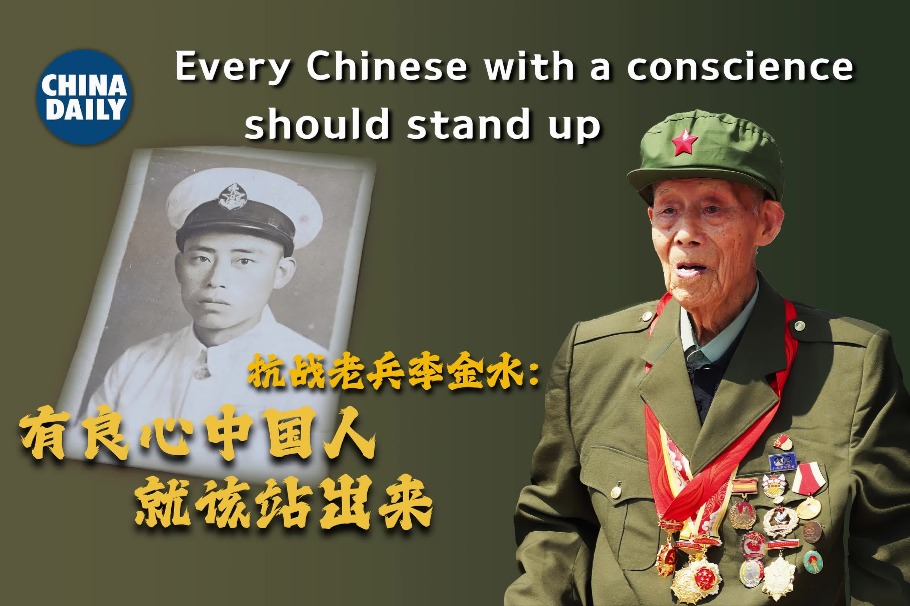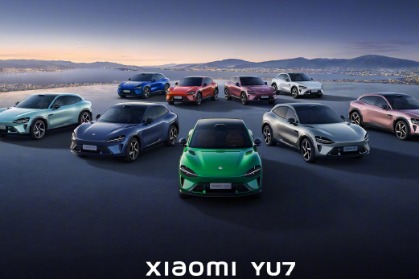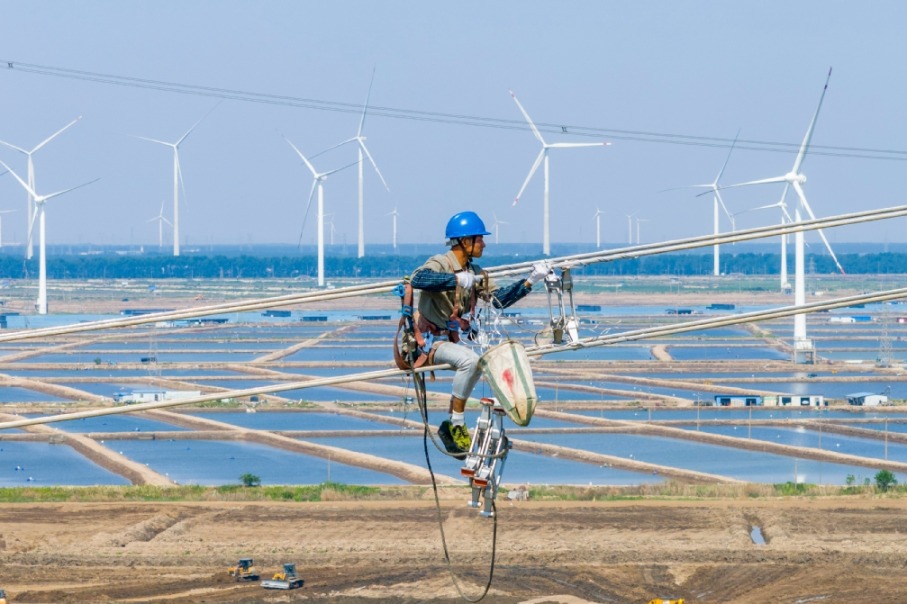Hard times call for fresh thinking

| An advertisement for Vigoss jeans in Guangzhou, Guangdong province. The designed-in-China jeans sell at some upmarket stores in the United States. Xin Lei / for China Daily |
Firms are moving out of the comfort zone for expansion after the global financial turmoil
Investors know that Warren Buffett once said: "Only when the tide goes out do you discover who's been swimming naked."
All Chinese learn in school that Confucius said: "Only when the cold season comes, then we know the pine tree and the cypress are the last to lose their leaves."
So in today's business world, with its rapidly changing tides and seasons, how can managers learn to swim while keeping their swimming costumes on? Or, how can companies transform themselves from ordinary ones, like trees that become dry and bald in the winter, into ones that can continue to grow in bad times, like evergreens?
More than three years after the outbreak of the global financial crisis, fresh answers are now being given by some Chinese companies on how to transform themselves from manufacturers of cheap goods into ones providing more value-added goods and services.
Among those more successful companies, no one is counting on more overseas orders for low-skilled processing operations.
No one is trying to produce more by hiring more cheap labor, especially when labor is no longer cheap, or by working long hours.
Everyone is competing by beefing up their tech teams, and through serious research and development and design management.
And everyone is trying to generate more value for customers. They may be leading the way among the post-crisis generation of Chinese entrepreneurship.
Emphasis on tech
TEK Electrical (Suzhou) Co Ltd now has its new products showcased on overseas websites about consumer gadgets. But in 1998, when it just started, it was a simple manufacturer of household cleaning appliances for overseas brands.
There's nothing extraordinary about that, as original equipment manufacturing was the game at that time in China, when coastal cities were competing for opportunities to make products or components for international companies under the latter's brand names.
But TEK Chairman Qian Dongqi did not believe in fate. He wanted to chase a lofty goal, even if it meant, he said, that he had to travel on a rocky path. He dreamed about creating his own brand, and he wanted to do so through innovation.
After "many failures", Qian began to market his intelligent cleaning robots in 2006. Ecovacs is now said to be a "well-established" brand of cleaning robots in the US and European markets.
From the company's showroom, the 47-year-old entrepreneur could explain lines of cleaning robots like his own children.
Winbot, for example, is a recently developed window-cleaning gadget that sells for $399 (319 euros) and is beginning to get good feedback from the market.
Right now, although OEM still accounts for 70 percent of TEK's annual sales, sales of branded products already accounts for more than 50 percent of the company's profit, showing a visibly higher markup than the former.
In the first quarter of this year, TEK's overseas trade reached $354.6 million, showing growth of 27.1 percent year-on-year. By contrast, the city of Suzhou, faced with a general decline in orders for made-in-China goods, saw its trade value grow just 0.7 percent from the same period last year.
TEK has been diverting around 50 million yuan ($7.87 million, 6.29 million euros), or more than 5 percent of its annual sales, to R&D. But that doesn't lend much sense of security to Qian.
"In China, you get crushed if you don't innovate, but you may also get crushed if you do," he says.
Innovation requires taking a lot more risks than OEM, in that companies have to manage their own business strategies and cope with all market caprices. While OEM, especially in times of no change, tends to generate steady and timely returns.
More importantly, to focus on innovation, for an enterprise of 3,500 employees and sales of 100 million yuan, also means resisting the temptation to just stay in the comfort zone or to chase speculative returns.
Managing relations
Wu Yixiong used to be one of the 3,000 factory owners who made a fortune making jeans in Xintang, a satellite town of Guangzhou dubbed China's "jeans capital".
But he did not want to be just one of the 3,000 factory owners who produce 60 percent of China's jeans and 40 percent of the world's, but do not own a single renowned brand name. He wanted to create his own brand.
Even among the few entrepreneurs who are seriously building their brands, Wu is unique. He leaves marketing and sales to local distributors while matching them with the most favorable designs.
Having discovered that the majority of the profit would go to brand owners, Wu registered his first trademark in 1995. But that was just a label for products based on the specifications and styles of an order placed by a Hong Kong merchant, and was doomed to failure.
After he shipped the jeans of his "brand" to the United States, he was dismayed to learn that they ended up not in shops, but in warehouses, because his specifications and styles were not for the US market, but for the European market.
"This taught me a great lesson," Wu says, recalling that somber experience.
It dawned on him that knowing local markets was the key - no matter how many of them there are. So he set about looking for and working with local designers in the US and Italy.
In order to get them interested in working for him, an obscure maker of jeans from China, he came up with generous terms - offering international designers royalty payments from sales.
"The more jeans are sold, the more money they earn," Wu says. "They are not working for me. They work for themselves." And it doesn't mean contracting just two or three of them.
The US, he says, "is like a United Nations", where styles change from region to region, and he has hired local designers across the nation.
The turning point came in 2007 when Wu's brand, Vigoss, successfully moved up from the just so-so level to the "mid- and high-end". It is now displayed at upscale department stores such as Bloomingdales in New York and sells for as much as $500.
Despite Wu's breakthrough designs, he is still cautious about setting foot in distribution and retail, saying that, as a foreigner, he is still at a disadvantage compared to local distributors.
Joint R&D
Unlike other successfully transformed former OEM companies, Suzhou Victory Precision Manufacture Co Ltd does not own a brand. Nor does it plan to have one.
You do not see its logo or name on the frame or the base of LCD television sets, but it makes parts for many major television brands, such as Philips, TPV, Sharp, LG, Haier and Hisense.
Victory Precision is, in fact, a designated qualified supplier for nine out of the top 10 global TV brands.
Or, you can say Victory Precision's "brand" is the way it does business: It has changed the traditional definition of OEM by taking part in the R&D process of its clients. Its practice is a brand-new type of OEM.
Victory Precision, a privately owned company, was founded in 2003. But almost as soon as it started, it learned that the days for its business model, called processing with supplied designs, were numbered.
As the general price level for consumer electronics would go down by an average 15 percent each year, its manufacturers, unless they could manage to keep on cutting costs at a corresponding speed, faced grim prospects.
Fearing it would get stuck with a business with no future, Victory Precision decided to opt for its only method of survival, says Cao Haifeng, its president. And that was to give a better show to its specialized competitive edge by working with its clients from the R&D stage.
Out of its 45,000-strong payroll, the company has around 130 R&D employees. They are divided into three teams, with the first team specializing in helping clients to improve their own designs of the frame.
The other two teams focus on developing their own ideas and recommend them to clients, ranging from solutions that will save components and reduce costs, to designs that will prove more appealing to customers.
Cao boasts that compared with some of the clients' original designs, Victory Precision's ideas can help them earn up to 20 percent more in profit.
zhengyangpeng@chinadaily.com.cn
(China Daily 06/15/2012 page22)
Today's Top News
- Nepal's hydropower a climate change solution
- UN Charter still guiding compass of humankind
- Leaders pledge to strengthen Sino-Senegalese relations
- China, Ecuador to support each other's core interests
- Details on trade talks confirmed
- Bolder steps likely to boost demand































